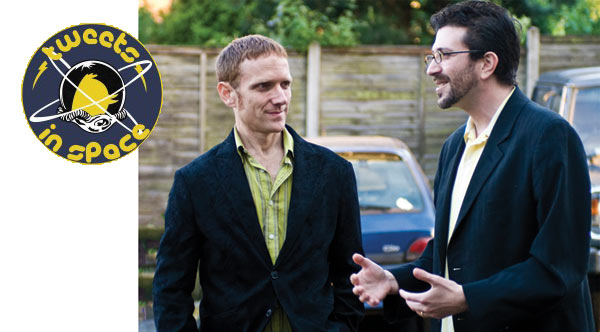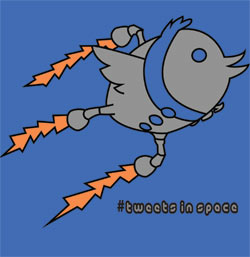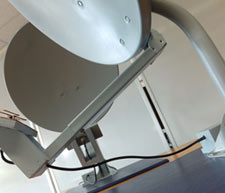
That’s when a project partially conceived at UWM with support from the National Geographic Channel ignites the Twittersphere with greetings from Earthlings.
Using radio-wave transmission, messages tweeted during the 30-minute “performance” with the hashtag #tweetsinspace will be beamed into deep space. For artists Nathaniel Stern and Scott Kildall, the digital dialogue blitz, called “Tweets In Space,” is part performance art, part global democracy and part communication research.
Though the event assumes there will be recipients for the multitude of messages, the idea isn’t as outlandish as it sounds, says Stern, UWM associate professor of art and design.
Transmission will be in the direction of GJ667Cc, a planet lying outside our galaxy that is most likely to have features necessary to support intelligent life, including access to water. It’s also the closest of the 777 known exoplanets.
“We look at this as one performance with two stages using the same Twitter data,” says Kildall, a San Francisco-based artist.

Viewers and contributors will be able to see and respond to each other’s messages in real time, while Kildall and Stern will be Twitter-streaming live at the International Symposium on Electronic Art (ISEA) in New Mexico. Feedback from the event will inevitably show up on outlets like Facebook and Instagram, leading to what Stern calls a “social media explosion.”
Linking with National Geo
If this sounds familiar, it’s because the National Geographic Channel hosted a global tweet-in of its own in June to promote a new program called “Chasing UFOs.” The channel’s producers also had tagged tweets transmitted into space.
But instead of derailing Stern and Kildall’s project, the National Geographic Channel became a partner, licensing and using the software developed by UWM alumnus Christopher Butzen (’11 B.F.A.) that allows the huge volume of tagged messages to be collected and archived from Twitter.
“National Geographic had the same idea we did, but we just got to the Internet first,” says Stern. “We had entirely different purposes and audiences. But they were great to partner with. They wanted to know how they could support us. We were planning on making our software open-source, but when they offered to license it, we were able to use that money toward our fundraising.”
Stern and Kildall also brought UWM engineering students into the project. Stern had originally asked a group of students enrolled in a product development course to design a method of transmission. The group, which included Nate Bruk, Alex Hughes, Justin Linnemeier, Matt Schleis and Alex Gueldenzopf, worked on the hardware for a delivery system. But, after building a prototype, they ultimately found it would be too expensive to develop and there were too many FCC regulations attached to using it.
Instead the students researched vendors and found Deep Space Communications Network, a Florida-based company that became a project partner. The students’ prototype will be on display at future exhibitions of the work.
Talk research

Stern and Kildall see the event as a way to probe the implications of social media on public conversation.
“This is an example of what I call ‘potentialized’ art,” says Stern. “It intentionally promises more than it can deliver, and asks us to explore that ‘more-than’ inside ourselves, through the discussion it engenders. It’s one way to dig into the possibilities for social media.”
It’s also about the evolving nature of both communication and technology. When Stern and Kildall use the term “democracy,” for example, they mean it in a generic sense. It refers to the freedom of hearing many perspectives, instead of receiving one voice, one point of view, says Kildall.
“Artistic and scientific methodologies have often historically led to the same result,” he says. “The artistic approach is just as exploratory as the scientific because you don’t know what the outcomes will be.”
Tweets with the hashtag are already appearing on Twitter, but only messages sent during the event will be beamed into space.
What happens after the performance? “In 44 years, we’ll be listening to see if anyone replies,” says Stern.



